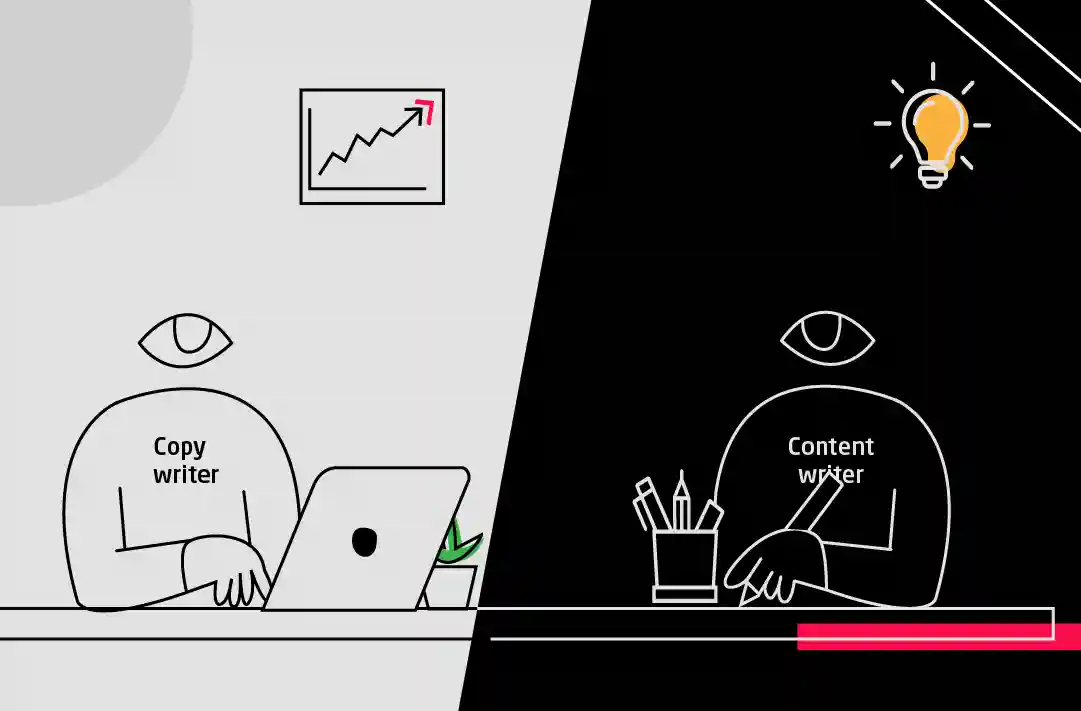Copywriting vs Content Writing: Key Differences between the two

It’s no news that content is king when it comes to implementing and executing any marketing strategy. Whether it’s about educating the mass about your products and services or about driving sales-oriented results, nothing yields better results than impact-driven words and proven statements.
Be it ads, blogs, posts, emails, banners, or any other conventional or digital asset curated for promotional and advertising purposes, it bears no fruit unless the visuals are complemented with rightly suited written content that can drive the audience to perform desired actions or establish an emotional connect with them.
Copywriting and Content Writing are two major pillars of any content marketing strategy, however, they are used quite interchangeably within the industry and hence it might become difficult to point out the exact differences between the two. If the line of distinction between Copywriting and Content Writing is still largely blurred for you or they often keep merging into one, then you’ve come to the right place to sort it out once and for all!
Here are some key differences between Copywriting and Content Writing that you must know:
Persuade vs Educate
When you read something written on an Instagram ad post or a hoarding, what does it usually sound like? The connotation is such that the written matter persuades you to not miss out on what is being offered. Copywriting hence is a text written with an aim to persuade the audience to take some action upon seeing the promotional content. This is achieved by employing the use of inviting words, strong CTAs, limited-time offers, and other such content marketing hacky tools.
Content Writing on the other hand is written with a purpose to educate the audience about your product or services. The aim here is to provide valuable information to the user that can further remain accessible to them indefinitely or for long periods of time. The content informs the audience about your business, and hence enables the cultivation of trust within the consumers by projecting a transparent and approachable brand image.
Expectation attached vs No Expectation
Continuing on from the above-discussed aspects, it becomes easy to realise that when a copy is written with an aim to persuade the audience to take action, there is also an underlying expectation attached to it i.e., the business expects the audience to be enticed by the copy and perform the desired action over the advertisement. If you see an Instagram ad telling you to redeem a 10% off coupon code on a clothing website, the brand expects that you will make a purchase from them and use this coupon code – hence driving their sales.
On the flip side, with content writing, there is no such expectation to take action attached to the piece of text for the audience. Content is simply written to educate, instruct, and inform the audience to develop trust between the brand and the audience and help the audience better engage with the brand. Product descriptions of different products on a website do not directly drive sales, but they help the consumer make a better and more informed purchase decision by letting them know every detail about the product.
Short-form Text vs Long-form Text
Copies are ideally written crisp and straight to the point. Any unnecessary elaboration might cause the purpose of the writing to lose clarity and may result in the delay of action taken by the audience. To avoid any ambiguity in communicating the purpose of the Call to Action, copies are written in a way that they abide by the constraints in word count but get the message across effectively. Ad posts, Newsletters, Emails and banners promoting special offers, Leaflets, etc. are some avenues where Copywriting is employed.
Content is usually longer text written with an educational or informative purpose as we’ve established above. In order to leave no ambiguity in the interpretation of the text, it is written in exceptional detail and no points are left unaddressed. Blogs, Emails, Website Content like product descriptions, Ebooks, etc. are some avenues where Content Writing is employed.

Short-term goal achievement vs Long-term goal achievement
Given that copies are written to incentivise the audience to take immediate action, they achieve a very focused and short-term goal.
Content Writing on the other hand drives results on a cumulative principle. It is focused to achieving long-term goals like achieving a loyal customer base for the brand over time, gradually upscaling the brand’s market position, and so on.
No Emotional Connect vs Establishing an Emotional Connection
As we witnessed above, copies are directed to the achievement of short-term and immediate goals. They hence do not need to emotionally resonate with the audience in order for the end goal to be achieved.
Content, however, achieves goals gradually and over time, and these goals are such that they call for a need to establish an emotional connection with the audience. Customer loyalty, for example, is unhurriedly achieved little by little, by making the customer believe your brand’s mission and trust the value your brand provides.
Apart from these factors, there are still many others that help us draw a clear contrast between Copywriting and Content Writing. The above-mentioned pointers however sum up most of the crucial differences between the two aspects and hence make it simpler to clearly point out dissimilarities between the two – enabling us to regard them as separate entities entirely.
Share-

Koda case study

Quirkeye case study




